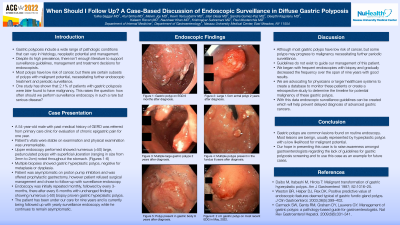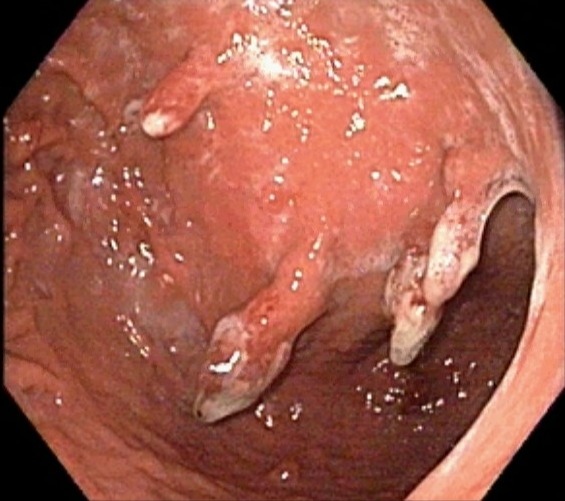Back


Poster Session B - Monday Morning
Category: Stomach
B0727 - When Should I Follow Up? A Case-Based Discussion of Endoscopic Surveillance in Diffuse Gastric Polyposis
Monday, October 24, 2022
10:00 AM – 12:00 PM ET
Location: Crown Ballroom

Has Audio
- TS
Presenting Author(s)
Tulika Saggar, MD, Melvin Joy, MD, Atul Sinha, MD, Kevin Yeroushalmi, MD, Jiten Desai, MD, Sandra Gomez-Paz, MD, Deepthi Kagolanu, MD, Nausheer Khan, MD, Krishnaiyer Subramani, MD
Nassau University Medical Center, East Meadow, NY
Introduction: Diffuse gastric polyposis is a rarely seen pathology without well defined surveillance guidelines. One study has shown that 2.1% of patients with gastric polyposis were later found to have malignancy.(1) This raises the question: how often should we perform surveillance endoscopy in such a rare but serious disease?
Case Description/Methods: A 54-year-old male with past medical history of GERD was referred from primary care clinic for evaluation of chronic epigastric abdominal pain for one year. Patient’s vitals on examination were stable and physical examination unremarkable. Upper endoscopy performed showed numerous ( >50) large, pedunculated polyps with superficial ulceration (ranging in size from 3mm to 2cm) noted throughout the stomach. Multiple biopsies showed gastric hyperplastic polyps, negative for metaplasia or dysplasia. Patient was asymptomatic on PPI and was offered prophylactic gastrectomy, however, patient refused and chose to follow-up with surveillance endoscopy. Endoscopy was initially repeated monthly, followed by every 3-months, followed by every 6-months with unchanged findings showing numerous ( >50) biopsy proven gastric hyperplastic polyps. The patient has been under our care for nine years and is currently being followed up with yearly surveillance endoscopy while continuing to remain asymptomatic.
Discussion: Guidelines do not exist to guide our management of this patient. We began with frequent endoscopies with biopsy and gradually decreased the frequency over the last nine years with good results. We chose to present this case because we would like to raise awareness amongst gastroenterologists about the lack of guidelines and to use this case as an example for future cases. We are advocating for physicians or larger healthcare systems to create a database to monitor these patients or create a retrospective study to determine the timeline for potential malignancy of these gastric polyps. With this data an endoscopic surveillance guideline can be created so that we can prevent the disaster of discovering gastric malignancy late in its course.
1: Daibo M, Itabashi M, Hirota T: Malignant transformation of gastric hyperplastic polyps. Am J Gastroenterol 1987; 82:1016–25.

Disclosures:
Tulika Saggar, MD, Melvin Joy, MD, Atul Sinha, MD, Kevin Yeroushalmi, MD, Jiten Desai, MD, Sandra Gomez-Paz, MD, Deepthi Kagolanu, MD, Nausheer Khan, MD, Krishnaiyer Subramani, MD. B0727 - When Should I Follow Up? A Case-Based Discussion of Endoscopic Surveillance in Diffuse Gastric Polyposis, ACG 2022 Annual Scientific Meeting Abstracts. Charlotte, NC: American College of Gastroenterology.
Nassau University Medical Center, East Meadow, NY
Introduction: Diffuse gastric polyposis is a rarely seen pathology without well defined surveillance guidelines. One study has shown that 2.1% of patients with gastric polyposis were later found to have malignancy.(1) This raises the question: how often should we perform surveillance endoscopy in such a rare but serious disease?
Case Description/Methods: A 54-year-old male with past medical history of GERD was referred from primary care clinic for evaluation of chronic epigastric abdominal pain for one year. Patient’s vitals on examination were stable and physical examination unremarkable. Upper endoscopy performed showed numerous ( >50) large, pedunculated polyps with superficial ulceration (ranging in size from 3mm to 2cm) noted throughout the stomach. Multiple biopsies showed gastric hyperplastic polyps, negative for metaplasia or dysplasia. Patient was asymptomatic on PPI and was offered prophylactic gastrectomy, however, patient refused and chose to follow-up with surveillance endoscopy. Endoscopy was initially repeated monthly, followed by every 3-months, followed by every 6-months with unchanged findings showing numerous ( >50) biopsy proven gastric hyperplastic polyps. The patient has been under our care for nine years and is currently being followed up with yearly surveillance endoscopy while continuing to remain asymptomatic.
Discussion: Guidelines do not exist to guide our management of this patient. We began with frequent endoscopies with biopsy and gradually decreased the frequency over the last nine years with good results. We chose to present this case because we would like to raise awareness amongst gastroenterologists about the lack of guidelines and to use this case as an example for future cases. We are advocating for physicians or larger healthcare systems to create a database to monitor these patients or create a retrospective study to determine the timeline for potential malignancy of these gastric polyps. With this data an endoscopic surveillance guideline can be created so that we can prevent the disaster of discovering gastric malignancy late in its course.
1: Daibo M, Itabashi M, Hirota T: Malignant transformation of gastric hyperplastic polyps. Am J Gastroenterol 1987; 82:1016–25.

Figure: Upper endoscopy revealing multiple gastric hyperplastic polyps
Disclosures:
Tulika Saggar indicated no relevant financial relationships.
Melvin Joy indicated no relevant financial relationships.
Atul Sinha indicated no relevant financial relationships.
Kevin Yeroushalmi indicated no relevant financial relationships.
Jiten Desai indicated no relevant financial relationships.
Sandra Gomez-Paz indicated no relevant financial relationships.
Deepthi Kagolanu indicated no relevant financial relationships.
Nausheer Khan indicated no relevant financial relationships.
Krishnaiyer Subramani indicated no relevant financial relationships.
Tulika Saggar, MD, Melvin Joy, MD, Atul Sinha, MD, Kevin Yeroushalmi, MD, Jiten Desai, MD, Sandra Gomez-Paz, MD, Deepthi Kagolanu, MD, Nausheer Khan, MD, Krishnaiyer Subramani, MD. B0727 - When Should I Follow Up? A Case-Based Discussion of Endoscopic Surveillance in Diffuse Gastric Polyposis, ACG 2022 Annual Scientific Meeting Abstracts. Charlotte, NC: American College of Gastroenterology.
